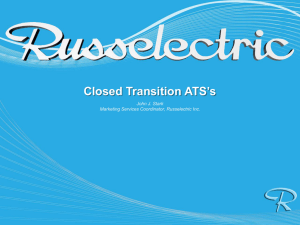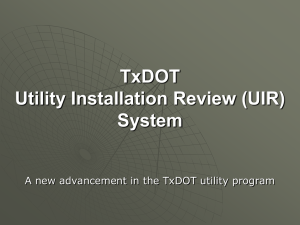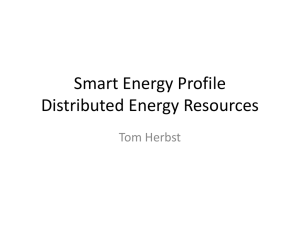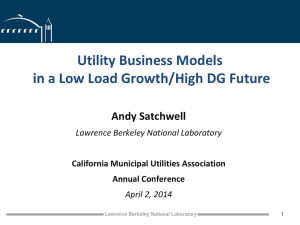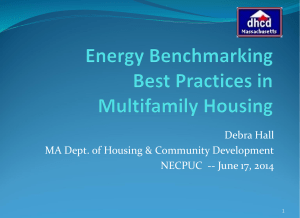Third Party Power purchase agreements in indiana
advertisement
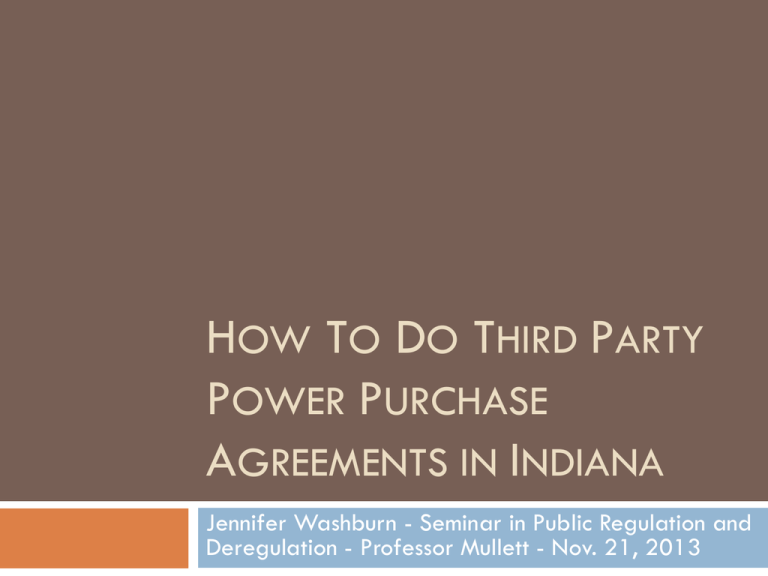
HOW TO DO THIRD PARTY POWER PURCHASE AGREEMENTS IN INDIANA Jennifer Washburn - Seminar in Public Regulation and Deregulation - Professor Mullett - Nov. 21, 2013 Ind. Code § 8-1-2-1(a) Definition of a Public Utility “Public utility” means every corporation, company, partnership, limited liability company, individual, association of individuals, their lessees, trustees, or receivers appointed by a court, that may own, operate, manage, or control any plant or equipment within the state for the: (1) conveyance of telegraph or telephone messages; (2) production, transmission, delivery, or furnishing of heat, light, water, or power; or (3) collection, treatment, purification, and disposal in a sanitary manner of liquid and solid waste, sewage, night soil, and industrial waste. The term does not include a municipality that may acquire, own, or operate any of the foregoing facilities. Ind. Code § 8-1-2.3-2 Definition of an Electricity Supplier “Electricity supplier” means a public utility, a local district rural electric membership corporation, or a municipally owned electric utility which furnishes retail electric service to the public. Indiana Code § 8-1-2.3-4 Service Area Rights Act Language of Statute (emphasis added): Service Area Rights. (a) As long as an electricity supplier continues to provide adequate retail service, it shall have the sole right to furnish retail electric service to each present and future consumer within the boundaries of its assigned service area and no other electricity supplier shall render or extend retail electric service within its assigned service area unless the electricity supplier with the sole right consents thereto in writing and the commission approves. This subsection does not prevent the commission from exercising its authority under IC 8-1-2-69. (b) If an electricity supplier unlawfully renders or extends retail electric service within the assigned service area of another electricity supplier, the electricity supplier which has the sole right to furnish retail electric service in that assigned service area may bring an action in the circuit or superior court of the county where such assigned service area is located to enjoin the other electricity supplier from rendering or extending such unlawful retail electric service. If a violation is proved, the violator shall pay to the aggrieved electricity supplier the gross revenues derived by the violator from the sale of electric service within the assigned service area of the aggrieved electricity supplier, all witness fees, court costs and reasonable attorneys' fees incurred in any litigation brought to enforce this section. Payment of damages, fees and costs does not entitle a violator to furnish retail electric service in such assigned service area. All such actions or proceedings must be brought within three (3) years after the violation occurs. Legislative Intent of Service Area Rights Act Legislative Intent It is declared to be in the public interest that, in order to encourage the orderly development of coordinated statewide electric service at retail, to eliminate or avoid unnecessary duplication of electric utility facilities, to prevent the waste of material and resources, and to promote economical, efficient, and adequate electric service to the public, the currently unincorporated areas of Indiana shall be divided into designated geographic areas within which an assigned electricity supplier has the sole right to furnish retail electric service to customers. Ind. Code Ann. § 8-1-2.3-1 U.S. Steel Corp. v. Northern Indiana Public Service Co., 951 N.E.2d 542 (Ind. Ct. App. 2011) Steel producer delivered electricity to competitor following parties' swap of facilities for competitor to use at producer's former facility located within producer's industrial complex. Did not act as an “electricity supplier” under Service Area Assignments Act. Was neither a local district rural electric membership corporation nor a municipally-owned electric utility, and was not acting as a public utility with respect to provision of electricity. Any attempt to impress public utility status upon private property not dedicated to public use constitutes a taking thereof for public use without just compensation in violation of the Fourteenth Amendment. Producers Transportation Co. v. Railroad Commission (1920), 251 U.S. 228, 230–231, 40 S.Ct. 131, 132, 64 L.Ed. 239. When a statute may be construed to support its constitutionality, such construction must be adopted. Miller v. State (1983), Ind.App., 449 N.E.2d 1119, 1121. The PSC Act passes constitutional muster in this regard only if the omitted language is read back into the amended “public utility” definition. Thus, the definition of “public utility” is read to include the requirement that the power be transmitted directly or indirectly to or for the public. BP Products North America, Inc. v. Indiana Office of Utility Consumer Counselor, 947 N.E.2d 471 (Ind. Ct. App. 2011) Key Facts Oil refinery entered into private contracts to provide the excess utility services it created through its refinery process to adjacent property owners and/or providers of services within the refinery business. This occurred within the designated exclusive sales territory of NIPSCO. Key Legal Considerations BP was not a “public utility” subject to jurisdiction of IURC; because refinery served a defined, privileged, and limited group of companies, a special class of entities that did not make up the indefinite public, it was engaged in a private activity, not the provision of services directly or indirectly to the public. [Compare to BP acting as a “public utility” when it sold low pressure raw service water to city, which city then treated and distributed to its customers; refinery's contract with city provided for the provision of water to an entity that was a mere conduit serving the undifferentiated public, at least indirectly. ] Accordingly, an entity listed in the statute cannot be a “public utility” unless it produces, transmits, delivers, or furnishes heat, light, water, or power “ ‘either directly or indirectly’ to the public.” See U.S. Steel Corp. v. Northern Ind. Pub. Serv. Co We noted that “[u]pon dedication of a business to a public use, it is established that such business is under a common law duty to serve all who apply so long as facilities are available without discrimination.” At the very minimum, “[i]tis an essential requirement that a business or enterprise must in some way be impressed with public interest before it may become a public utility.” Id. at 506. We further noted that whether a given business is a public utility “depends on whether or not the service rendered by it is of a public character and of public consequence and concern, which is a question necessarily dependent on the facts of the particular case.” Id. BP was not an “electricity supplier” and, thus, was not in violation of statute governing service area rights. Recent Case from IOWA SZ Enterprises, LLC d/b/a Eagle Point Solar v. Iowa Utilities Board Key Facts Eagle Point Solar asked for a declaratory ruling (based on hypothetical facts) to declare whether it would be designated a “public utility” and “electric utility” under Iowa law and if so, whether it would be prohibited from constructing a solar facility to serve City of Dubuque within utility’s exclusive service area. City of Dubuque trying to develop RE but various impediments including technical and financial risk, upfront costs, and inability to utilize tax credits or incentives. City seeks to enter into a special form of long-term financing agreement with Eagle Point (aka third-party power purchase agreement) Eagle Point would finance, install, own, operate and maintain on-site PV located on City’s premises to supply a PORTION of City’s electricity needs. Iowa Utility Board prohibited Eagle Point after utility complained that they project violated exclusive right to provide electricity to City. But the Polk County District Court found that it would not be acting as a utility, so it can sign PPA with City! Now in the Iowa Supreme Court. Recent Case from IOWA SZ Enterprises, LLC d/b/a Eagle Point Solar v. Iowa Utilities Board Key Legal and Policy Considerations Factors in determining whether an entity is a public utility: (1) what the corporation actually does, (2) a dedication to public use, (3) articles of incorporation, authorization, and purposes; (4) dealing with the service of a commodity in which the public has been generally held to have an interest; (5) monopolizing or intending to monopolize the territory with a public service commodity, (6) acceptance of substantially all requests for service, (7) service under contracts and reserving the right to discriminate is not always controlling, and (8) actual or potential competition with other corporations whose business is clothed with public interest. Eagle Point would not be able or required to meet all requests for service and it would not be competing with the utility or creating a monopoly of its own. The solar panels would not meet all of the building’s electricity needs, hence the building would still be hooked up to the grid and buying electricity from the Company. The building’s demand for electricity from the grid would be reduced, but this would be equivalent to the demand reduction created by energy efficiency measures like weatherization. Hypothetical University in IOU’s exclusive electric service territory would like to install solar PV generation on its premises. However, the university does not have enough upfront capital and cannot take advantage of any tax breaks or incentives because it is not a for-profit entity. University would like to contract with a for-profit renewable energy developer called SecondSolar to install and own solar PV generation on its site. What options does the university have in Indiana? Third-Party PPA Model from Technical Report NREL/TP-6A2-46723 Third-party PPA model where a customer interested in hosting solar panels signs a PPA with a project developer who builds, owns, and operates a solar energy system on the customer’s site, also known as the host site. The developer then sells the electricity back to the customer via the long-term PPA. In effect, this allows the customer to have the benefits of solar power while transferring the up-front capital costs to an entity designed to capture available tax benefits (with a potentially lower cost of capital) and foregoing the logistics of financing, building, and maintaining the system. Establish that the Third Party Developer is Not a Public Utility Would SecondSolar be a Public Utility? Not directly or indirectly serving public—just the school, so merely a private activity Instead, would be serving a defined, privileged, and limited group—would not make up the indefinite public. Persuasive Authority Consider the Eagle Point Factors in determining whether an entity is a public utility: (1) what the corporation actually does, (2) a dedication to public use, (3) articles of incorporation, authorization, and purposes; (4) dealing with the service of a commodity in which the public has been generally held to have an interest; (5) monopolizing or intending to monopolize the territory with a public service commodity, (6) acceptance of substantially all requests for service, (7) service under contracts and reserving the right to discriminate is not always controlling, and (8) actual or potential competition with other corporations whose business is clothed with public interest. Would SecondSolar be an Electric Utility? If not a public utility, then not an electric utility. Would SecondSolar be violating the Service Area Rights Act? If it is not a public utility and thus not an electric utility, it would not be violating the Act. Interconnection Issues (170 IAC 4-4.3) Interconnection standards are the legal rules and procedures for plugging a RE system into the grid, which includes technical and contractual terms that both system owners and utilities must follow. Three levels of interconnection to customer-generators. Level 1 for up to 10kW Level 2 for up to 2MW Level 3 for above 2MW. Any disputes between customers and utilities will be settled according to the IURC's consumer-complaint rules. Issues: If signed interconnection agreement not promptly returned to customer, lag to customer if wanting to sell SRECs/RECs. [Related net metering rule silent as to who gets the RECs, although some utilities allow customers to retain these.] Utility’s discretion for external disconnect switch. Relying on utility to install equipment such as bi-directional meters on a timely basis. Possibility that utility will require installation of updated (or unnecessary) power supply lines and transformers even for insubstantial amounts of DG power. Changing quotes—might start off as “free” to hook up to grid, but then required several thousand dollar charge to do so. Then, tried to require a “Minimum Use” contract before utility would install service. Tariff Issues (170 IAC 4-4.2) Net metering rule (170 IAC 4-4.2 et seq) is a floor, not a ceiling. Retail rate credit to customer’s bill with indefinite carryover into subsequent billing periods. Possible impediments under rule: If different meters, different customers, or not customer-owned and operated If over 1MW, then have to go to sell to the utility at PURPA’s avoided cost rate rather than credited at retail rate Interconnection Issues If a utility so chooses, it could revise its utility-specific Net Metering Tariff to provide better options for its customers rather than the floor of the Net Metering Rule: Third Party Financing—allow customers to have a leasing agreement with a third party to finance the operation and still be eligible to net meter Third party leasing arrangements are part of a few utilities’ FIT programs now, including NIPSCO and IPL. Aggregate Net Metering—allows customer to apply net excess generation over multiple meters on contiguous parcels of land owned by customers (e.g. school system or group of muni buildings) Community Net Metering—allows different customers with their own meters but contiguous properties in a neighborhood to apply net excess generation amongst several customers Virtual Net Metering—allows net metering amongst non-contiguous properties of the same customers, such as chain of restaurants or gas stations. Possible Solution #2: If Public Utility, Could Ask for Declination of Commission Jurisdiction. Under Ind. Code §8-1-2.5-5, public utility can ask Commission to decline to exercise any jurisdiction to regulate, under Ind. Code 8-1-2. Pro: It has been done before. 43851 Liberty Green Renewables, 43882 Bioenergy LLC, 43068 Benton County Wind Farm, 43678 Meadow Lake Wind Farm, 43740 Lakefield Wind Project, 44336 Lake County Solar, 44358 Headwaters Wind Farm, 44299 NextEra Energy Bluff Point, 44304 Sunrise Energy Ventures, 44246 St. Joseph Energy Center, 44335 Wildcat Wind Farms Con: Not a standard offer, so would have to go project-by-project to Commission, which requires legal fees, etc. to do this. Possible Solution #3: Revise the Alternative Regulatory Statutes (Ind. Code §8-1-2.5-4) Indiana Industrial Energy Consumers, Inc., Position Paper which was provided to State legislators points out the onesidedness of AUR. Energy utility may propose a form of alternative regulation that deviates from traditional utility law, but no other party can. And if the IURC modifies the plan, the utility can withdraw the proposal. INDIEC suggesting: AUR Act should be amended to permit parties other than energy utilities (i.e. consumers) to propose alternative regulatory plans for approval by the Commission Amending the AUR Act to permit other interested parties to propose alternative regulatory plans, without providing the utility with veto power over any resulting Commission order, would restore balance to the statutory mechanism and would permit the Commission to consider alternative proposals, such as a pilot program for electric choice. THANK YOU!


